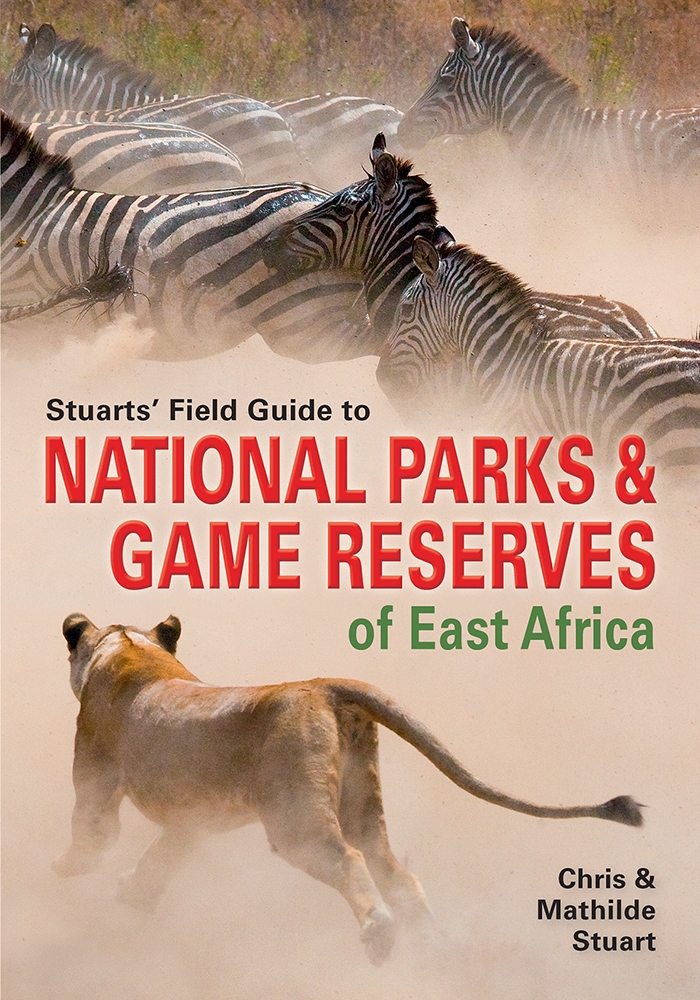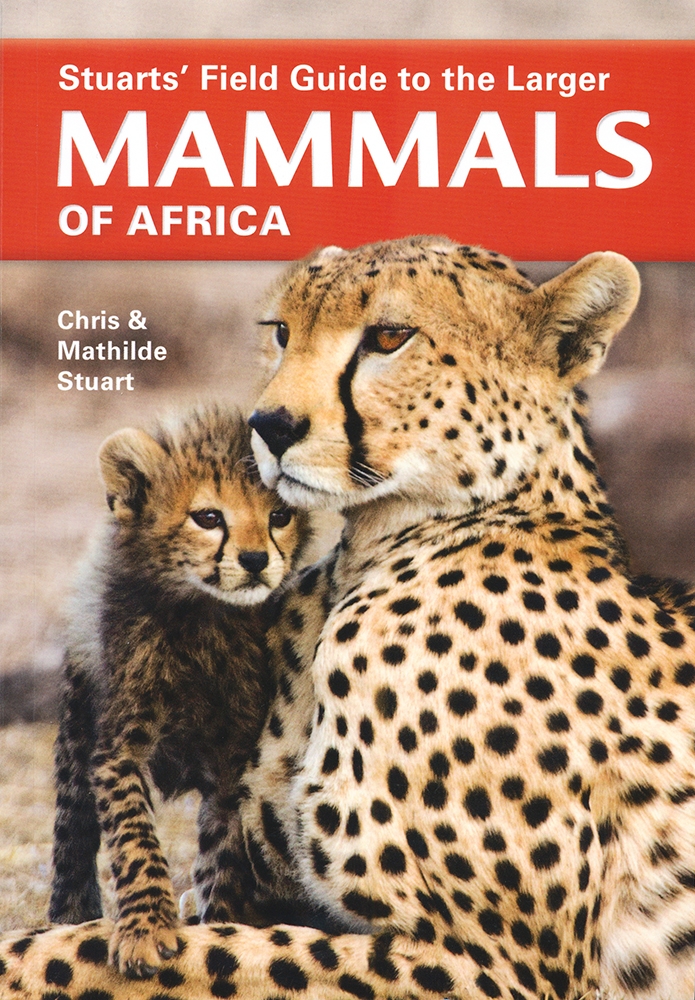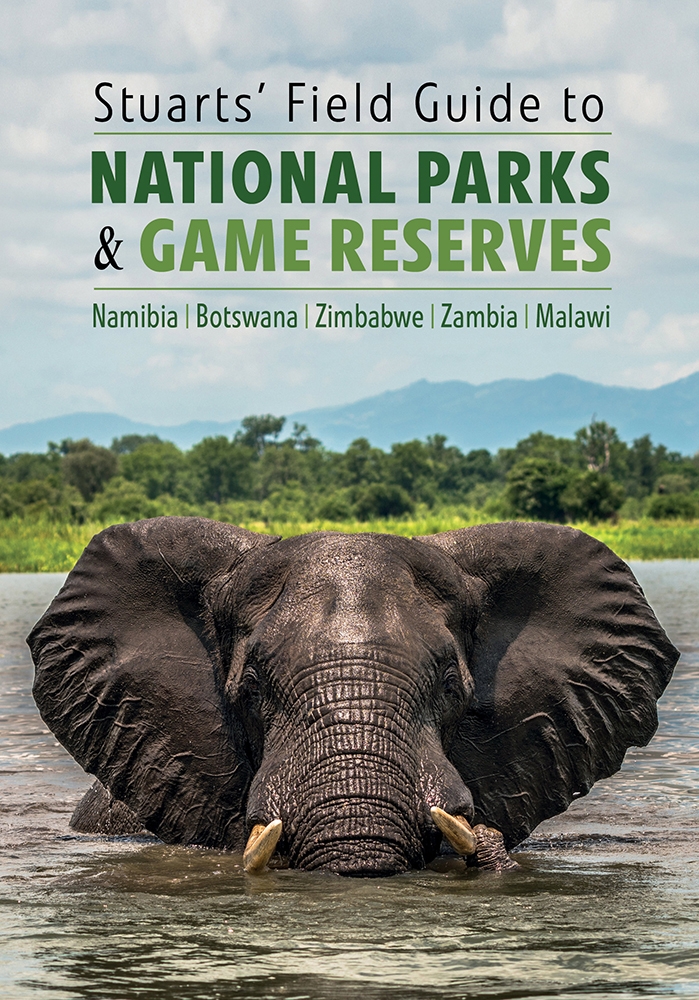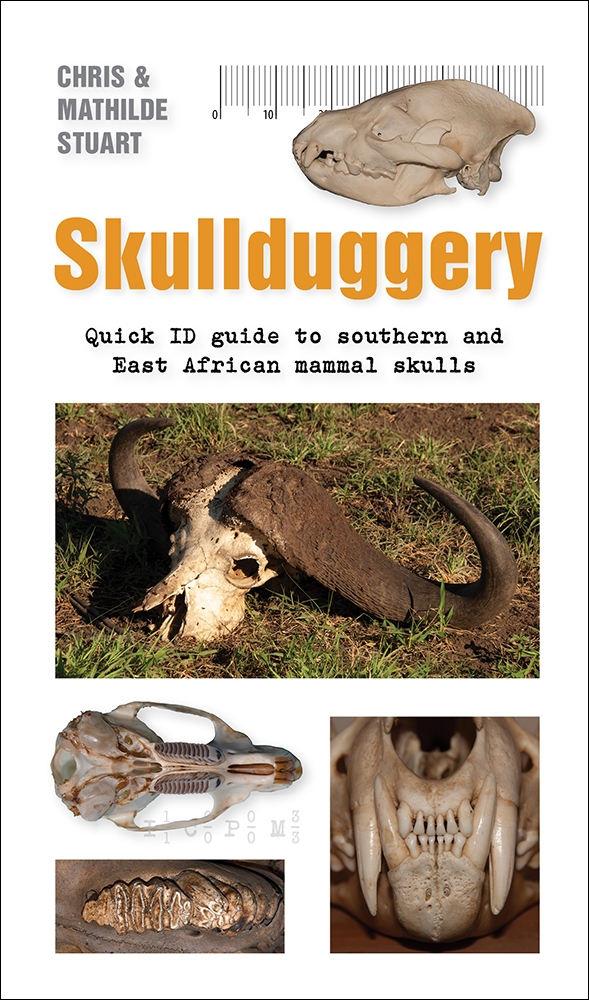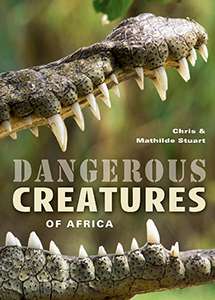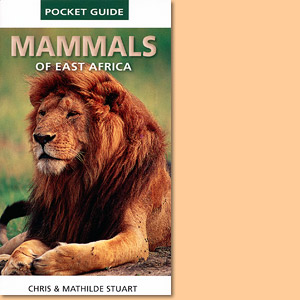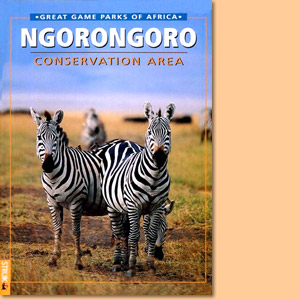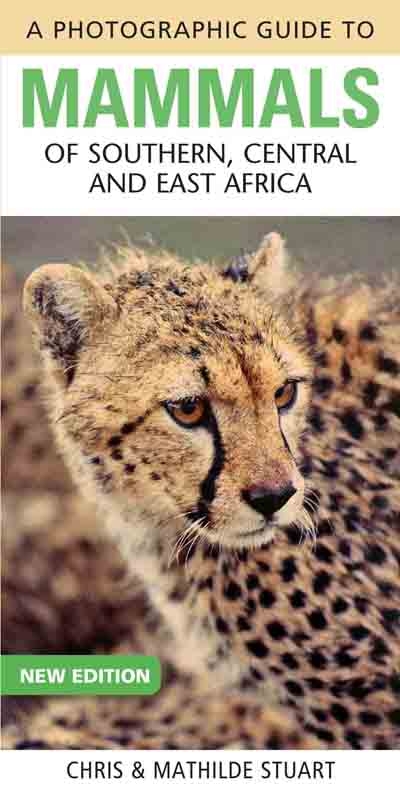Mammals of Southern Africa Pocket Guide, by Chris Stuart and Tilde Stuart
Authoritative and colourfully illustrated, Mammals of Southern Africa Pocket Guide, written by Chris Stuart and Tilde Stuart, offers concise information.
Southern Africa has more than 350 mammal species, a great diversity of habitats and a wealth of natural beauty. It encompasses both the oldest desert in the world, the Namib, and the well-watered Okavango River Delta, the largest inland delta on Earth. Two great oceans lap the region's shores, the Atlantic to the west and the Indian to the south and east. The region has majestic mountain ranges such as the Drakensberg and Soutpansberg, significant rivers that include the Limpopo, Zambezi, Cunene and Orange (Gariep), and the vast, arid lands of the Kalahari, Namaqualand and the Great Karoo. Politically, southern Africa consists of South Africa, Namibia, Botswana, Zimbabwe, Mozambique, Swaziland and Lesotho. However, wildlife has been greatly depleted in Swaziland, and little remains in Lesotho. The vegetation map (page 6) has been greatly simplified but does indicate seven of the most important vegetation zones across the region. Botswana and Namibia have relatively low human populations and extensive tracts of largely unspoilt habitat still remain. Recent warfare in Mozambique, and civil unrest and instability in Zimbabwe have resulted in considerable reductions in game mammal numbers. However, recently improved levels of protection in Mozambique have increased the populations of antelope and other game species in the country.
The subcontinent has a fairly extensive network of national parks, game reserves and private wildlife ranches with a great diversity of habitats and species. In general, the countries of southern Africa have a good record in the field of conservation, but some parts have seen a decline in motivation and finances, and a shortage of adequately trained staff. This book focuses on the larger, more visible species, but also includes a few of the more unusual species, such as the pangolin, aardvark and porcupine, as well as representatives of the different families and genera of bats, shrews, sengis and smaller rodents. Although not frequently seen, they are nevertheless as interesting and diverse as the larger species, and if you are lucky, you may catch a glimpse of some of these denizens of the skies and undergrowth.
How to use the Mammals of Southern Africa Pocket Guide:
Information is compiled with a view to easy identification of the larger and more conspicuous mammals of southern Africa, as well as a few of the less frequently seen, yet distinctive, species.
Name: The common English and scientific names are given, as well as those in Afrikaans, German and French.
Identification pointers: Provides a summary of the animal's most distinctive features.
Similar: Provides names of similar species, or those in the region with which the species is confused, and highlights distinguishing characters.
Habitat: Describes the terrain in which the animal lives; an important aid in identifying a mammal, especially in conjunction with the map.
Behaviour, Food and Reproduction: These are added for interest, but also aid identification. If a species is known to be solitary and you think you have seen it in a herd, read through the text describing behaviour in order to establish an alternative identity.
Longevity: Information on how long the species is known to live.
Calls: The most frequently heard calls are given.
Occurrence: The major parks and reserves in which a species occurs, its conservation status and numbers, if known.
Measurements: Those of male and female are given separately where they differ significantly. Measurements and weights give either known range, or averages, but there may be considerable variations. Also includes silhouette drawings of the species, with that of a human figure, arm or hand for comparison of scale. For so-called 'trophy' species, we have given the Rowland Ward records for southern Africa, but for some we have given those for East Africa and Africa as a whole, where more comprehensive records are available. Larger specimens may be known from beyond the region and these records change on a fairly regular basis.
Tracks: Drawings of typical tracks (where available) add interest and serve as tools for species identification, as do the dung images in the back of the book. Light grey areas on the tracks show only on soft ground.
Maps: Illustrate range across which the species occurs (red), and the historical distribution (pale tint); marine mammal concentrations are shown in dark blue.
This is an extract from the guide: Mammals of Southern Africa Pocket Guide, by Chris Stuart and Tilde Stuart.
Book title: Mammals of Southern Africa
Series: Pocket Guide
Authors: Chris Stuart; Tilde Stuart
Publisher: Randomhouse Struik
Cape Town, South Africa 2011
ISBN 9781770078611
Softcover, 11x18 cm, 160 pages, throughout colour photos
Stuart, Chris und Stuart, Tilde im Namibiana-Buchangebot
Mammals of Southern Africa Pocket Guide
Authoritative and colourfully illustrated, Mammals of Southern Africa Pocket Guide offers concise information.
Traveller's Wildlife Guide Southern Africa
Traveller's Wildlife Guide Southern Africa introduces 500 of Southern Africa’s most common amphibians, reptiles, birds, and mammals.
Stuart's Field Guide to National Parks and Game Reserves of East Africa
Stuart's Field Guide to National Parks and Game Reserves of East Africa provides an overview of some 58 protected areas across East Africa.
Stuarts’ Field Guide to the Larger Mammals of Africa
Stuarts’ Field Guide to the Larger Mammals of Africa concentrates on the more visible and easily distinguished larger species.
Stuarts' Field Guide to the Tracks & Signs of Southern, Central and East African Wildlife
Stuarts' Field Guide to the Tracks & Signs of Southern, Central and East African Wildlife, this is the 5th revised edition.
Stuarts' Field Guide to National Parks and Nature Reserves of Namibia, Botswana, Zimbabwe and Zambia
Stuarts' Field Guide to National Parks and Nature Reserves of Namibia, Botswana, Zimbabwe and Zambia.
Carnivores: Quick ID guide to Africa's predatory mammals
Carnivores: Quick ID guide is a compact and quick ID identification guide to Africa's predatory mammals.
Flying Mammals Quick ID guide to the bats of Africa
Flying Mammals Quick ID is a compact and quick ID identification guide to the bats of Africa.
Avian Architects: Quick ID guide to nests and eggs of southern African birds
Avian Architects: Quick ID is a compact and quick ID identification guide to nests and eggs of southern African birds.
Primates: Quick ID guide to Africa's great apes, true monkeys and their relatives
Primates Quick ID is a compact and quick ID identification guide to Africa's great apes, true monkeys and their relatives.
Skullduggery: Quick ID guide to southern and East African mammal skulls
Skullduggery is a compact and quick ID identification guide to skulls of southern and East African mammals.
My first book of Southern African animal tracks
My first book of Southern African Animal Tracks introduces 55 different types of animals and their footprints.
Stuarts' Field Guide to Mammals of Southern Africa
Stuart's Field Guide to Mammals of Southern Africa covers near to 400 mammal species including Angola, Zambia and Malawi since the 5th edition of 2015.
Behaviour briefs: Quick guide to southern and East African animal behaviour
Why do they do that and what next? Behaviour briefs is a quick guide to southern and East African animal behaviour.
On Track: Quick ID Guide to Southern and East African Animal Tracks
On Track is a quick identification guide to tracks of Southern and East African most commonly found mammals, reptiles, rodents, birds and insects.
A Field Guide to the Tracks & Signs of Southern, Central and East African Wildlife
Latest edition of A Field Guide to the Tracks & Signs of Southern, Central and East African Wildlife.
Stuarts' Field Guide to National Parks and Nature Reserves of South Africa
Stuarts' Field Guide to National Parks and Nature Reserves of South Africa offers a comprehensive overview of 43 parks, reserves and wilderness areas.
Dangerous creatures of Africa
The focus of Dangerous creatures of Africa is on understanding, identifying, avoiding and surviving these potential hazards of the African wilds.
Taschenführer: Säugetiere, Südliches Afrika
Der Taschenführer Säugetiere: Südliches Afrika, legt seinen Schwerpunkt auf die größeren, öfter gesehenen Tierarten, schließt allerdings auch einige ungewöhnliche Arten ein.
Mammals Of East Africa Pocket Guide
Mammals Of East Africa Pocket Guide covers all of the common and some of the less common mammal species.
Field Guide to Mammals of Southern Africa
A total of 337 species are covered in this fully revised comprehensive field guide to mammals of Southern Africa.
Field Guide to the Larger Mammals of Africa
Field Guide to the Larger Mammals of Africa provides over 400 colour photos, with concise, pertinent information highlighting the diagnostic features of each species.
Ngorongoro Conservation Area
From the series 'Great Game Parks of Africa' this is a portrait of the Ngorongoro Conservation Area.
Sasol Roadside Guide. Cape Town-Port Elizabeth: Discovering Nature Along the N2
The Sasol Roadside Guide Cape Town-Port Elizabeth: Discovering Nature Along the N2 interprets the surrounding countryside - plants, birds, mammals, reptiles, agriculture, geology.
A Photographic Guide to Mammals of Southern, Central and East Africa
A Photographic Guide to Mammals of Southern, Central and East Africa introduces 152 mammal species of each family group.
Field Guide to Tracks and Signs of Southern and East African Wildlife
Related to Southern African and East African Wildlife, this great field guide is about their tracks and signs, like droppings, feeding signs, scent marks and others.




